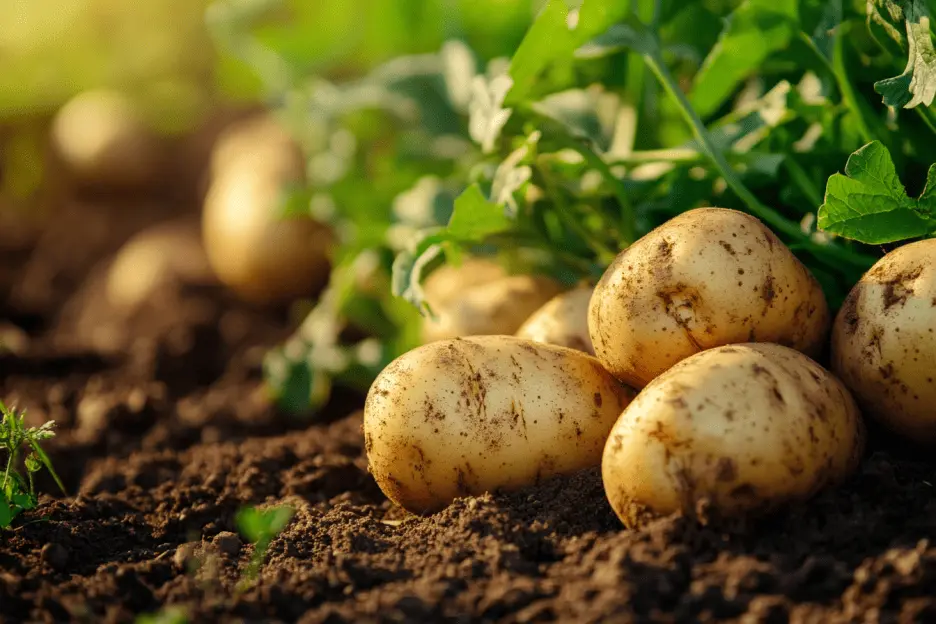Growing potatoes in your backyard is a rewarding experience, offering fresh, homegrown produce. With proper care and attention, you can cultivate a thriving potato crop, whether you have a large garden or a small space. Follow this comprehensive guide to successfully grow potatoes and enjoy a bountiful harvest.
1. Introduction to Growing Potatoes
Homegrown potatoes not only taste better, but they also provide a fun and cost-effective way to produce your own food. By growing potatoes, you reduce the need for store-bought varieties while enjoying the benefits of fresh, organic produce.
Why Grow Potatoes at Home?
- Better Flavor: Freshly harvested potatoes offer superior taste compared to store-bought options.
- Cost Savings: Growing your own potatoes can save money over time, especially if you harvest multiple crops in a season.
Ideal Growing Conditions
- Climate: Potatoes thrive in cooler climates but can grow in various regions with the right care.
- Sunlight: Ensure your potatoes receive at least 6 hours of direct sunlight daily for optimal growth.
- Space: Potatoes can grow in garden beds or containers, making them suitable for both large and small gardens.

2. Step-by-Step Guide to Planting Potatoes
To grow potatoes successfully, start with proper planting techniques. Following these steps ensures a healthy crop from start to finish.
Step 1: Choose Seed Potatoes
Selecting the right variety is key to a successful harvest. Choose certified seed potatoes suited for your region, such as Yukon Gold or Russet.
Step 2: Prepare Seed Potatoes
Before planting, cut large seed potatoes into smaller pieces, ensuring each piece has at least one “eye.” Allow them to cure for a few days to prevent rotting after planting.
Step 3: When and Where to Plant Potatoes
The best time to plant is early spring, once the soil temperature reaches around 45°F. Prepare the soil by loosening it to a depth of 12 inches to ensure proper root growth.
Step 4: How to Plant Potatoes
Dig trenches 4 inches deep, and plant the potato pieces 12 inches apart with the eyes facing upward. Cover the potatoes with 2-3 inches of soil to protect them as they start to grow.
For additional tips on organic soil preparation, visit this guide.
3. Caring for Potato Plants
Once planted, potatoes require consistent care to ensure healthy growth. The following practices will keep your plants thriving.
Watering Requirements
Potatoes need regular watering, but it’s essential to avoid overwatering. Water deeply once or twice a week, ensuring the soil stays moist but not soggy.
Hilling the Potatoes
As potato plants grow, you’ll need to “hill” them. Mound soil around the base of the plants to cover the stems, which helps encourage tuber production and prevents sunlight from reaching the developing potatoes.
Fertilizing Potatoes
Fertilize potatoes with compost or well-rotted manure. Organic fertilizers promote healthy soil and plant growth without the risk of chemical buildup.
4. Potato Plant Care: Light, Soil, and Temperature
Maintaining the right conditions for your potato plants is crucial to their success.
Light Needs
Potatoes need full sun, receiving at least 6 hours of sunlight each day to ensure strong growth.
Soil Requirements
Potatoes thrive in loose, well-draining soil with a slightly acidic pH between 5.0 and 7.0. If your soil is heavy, consider adding compost to improve drainage and soil structure.
Temperature Considerations
Potatoes are sensitive to extreme temperatures, especially frost. Protect your plants by covering them during cold spells, and avoid planting too early in the season.
5. How to Harvest Potatoes
Knowing when and how to harvest potatoes is key to enjoying a bountiful crop.
When to Harvest
Potatoes are ready to harvest when the plant’s foliage begins to yellow and die back. For new potatoes, harvest once the plant flowers, while fully mature potatoes can be harvested a few weeks later.
How to Harvest Potatoes
Use a garden fork or shovel to gently dig up the potatoes. Start by loosening the soil around the plants, taking care not to damage the tubers. Lift the plants and shake off excess soil.
6. Storing and Curing Potatoes
To store potatoes long-term, it’s important to cure them properly after harvesting.
Curing Potatoes
Curing potatoes hardens their skins and extends their shelf life. Place the freshly harvested potatoes in a cool, dark, and well-ventilated area for 1-2 weeks.
How to Store Potatoes
Once cured, store the potatoes in a cool, dark place such as a root cellar or basement. Ensure the storage area is around 45°F, with good airflow to prevent rot.
For more detailed advice on storing potatoes, visit this guide from The Old Farmer’s Almanac.
7. Common Pests and Diseases Affecting Potatoes
Potatoes can be susceptible to pests and diseases, but with the right prevention methods, you can keep your plants healthy.
Preventing Potato Blight
Potato blight is a common disease that can ruin your crop. To prevent blight, rotate crops regularly and plant blight-resistant varieties. If you notice brown spots on the leaves, remove the affected parts immediately.
Dealing with Potato Pests
Pests like Colorado potato beetles and aphids can harm potato plants. Encourage beneficial insects, such as ladybugs, and use organic pest control methods like neem oil to keep infestations in check.
8. Tips for Maximizing Your Potato Harvest
By implementing strategic gardening techniques, you can improve your potato yield.
Companion Planting for Potatoes
Plant potatoes alongside marigolds or basil to repel pests naturally. Companion planting can improve growth and protect your crops from insects.
Succession Planting
To get multiple harvests in one season, consider succession planting. After the first crop is harvested, plant a second round of potatoes for continued production.
Frequently Asked Questions (FAQs)
Q: What are the best potato varieties for home gardens?
A: Popular varieties include Yukon Gold, Russet, and Fingerling for their versatility and flavor.
Q: How do I avoid diseases like potato blight?
A: Practice crop rotation, choose disease-resistant varieties, and ensure good airflow around your plants to prevent blight.
Q: Can I grow potatoes in containers or bags?
A: Yes, potatoes thrive in containers as long as they have adequate depth and drainage. Grow bags are a great option for small spaces.
Conclusion
Growing potatoes in your backyard is a rewarding and straightforward process. With the right planting, care, and harvesting techniques, you can enjoy fresh, homegrown potatoes throughout the season. Start your potato garden today and experience the satisfaction of a bountiful harvest!


1 thought on “How to Grow and Care for Potatoes in Your Backyard”